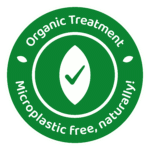Microplastic-Free Agricultural Products
Sustainable Solutions for a Cleaner Future
Sustainability starts at the seed. Since 2014, Ad Terram has been pioneering the development of microplastic-free solutions for seed coatings, biostimulants, and other agricultural inputs — combining professional performance with care for the environment.
Our commitment is simple: We develop and produce agricultural treatments and lead the way towards a microplastic free industry without compromising in price and quality.
The Challenge of Microplastics in Agriculture
Microplastics are small plastic particles (less than 5 mm) that do not degrade in nature. In agriculture, they are used in a range of applications — such as seed coatings, fertilizers, soil conditioners, and other agricultural treatments.
Once these particles enter the soil, they remain for decades — potentially affecting soil structure, microbial balance, and water quality. Because they cannot be filtered out, microplastics accumulate over time, creating long-term environmental challenges.
The European Union has recognized this issue and now regulates the intentional use of microplastics under REACH, ensuring a shift towards cleaner, biodegradable alternatives across industries — including agriculture.
The EU Microplastics Restriction
Microplastics have been officially recognized by the European Commission as a long-term environmental pollutant. To address this, the European Chemicals Agency (ECHA) introduced a landmark restriction under REACH (Registration, Evaluation, Authorisation and Restriction of Chemicals) — the EU’s main chemical safety regulation.
This restriction, established through Commission Regulation (EU) 2023/2055, was adopted in September 2023 and added to Annex XVII of REACH. Its purpose is to minimize the release of intentionally added microplastics into the environment.
Key Points of the Regulation
Scope
Applies to all mixtures containing intentionally added synthetic polymer microparticles that meet the EU definition of microplastics — including seed coatings and other agricultural formulations.
Agricultural relevance
Seed coatings, fertilizers, soil conditioners, and other agricultural treatments, fall directly within this scope.
Transition period:
Agricultural and horticultural applications — including seed coatings, fertilizers, and other agricultural treatments — must comply by October 2028. For plant protection products, treated seeds, and biocidal products, a longer transition period applies, with a compliance deadline of October 2031. After these respective dates, products containing intentionally added microplastics can no longer be placed on the EU market.
Objective
To prevent the build-up of persistent microplastics in soil and water systems, supporting the EU Green Deal and Zero Pollution Action Plan.
Ad Terram’s Early Compliance
Ad Terram has been developing microplastic free solutions since the beginning. Our agricultural formulations were developed without synthetic polymers long before the EU restriction was introduced — ensuring future proof products.
This proactive approach gives our partners confidence and continuity: no need for reformulation, no risk of non-compliance, and full alignment with upcoming EU legislation.
Independently Verified — Flustix Certified Microplastic-Free
To ensure complete transparency, Ad Terram’s seed treatment products and biostimulants are independently verified and certified by Flustix, Europe’s leading certification body for microplastic-free products.
The Flustix label confirms that our products contain no intentionally added synthetic microplastics, meeting strict compositional, environmental, and performance standards.
This certification provides clear and verifiable proof of compliance, ensuring our partners have reliable, regulation-compliant, and future-proof products they can trust.
With certified transparency and early innovation, Ad Terram demonstrates that compliance, sustainability, and performance can move forward together.
Setting the Standard for Microplastic-Free Seed Treatment Solutions
At Ad Terram, we didn’t replace microplastics — we never used them. Our solutions have been microplastic-free from the very beginning. Our seed treatment products are designed to maintain professional performance without relying on synthetic polymers.
- Uniform coverage
- Excellent flowability and dust reduction
- Compatibility with biological ingredients
- Full biodegradability in the soil
Our solutions ensure reliable application and consistent coating quality — enabling a smooth shift toward polymer-free, sustainable seed treatment.
Explore our microplastic-free seed treatment products here.
Our Microplastic-Free Technology
100% Microplastic-Free by Design
All our agricultural products are free from intentionally added microplastics and formulated using natural, plant-based materials that meet the highest standards of functionality and environmental safety.
Story of Ad Terram
Biodegradable Within 12 Months
Our agricultural products are biodegradable in the soil within 12 months, ensuring full breakdown and no long-term residue.
Seamless Integration
Ad Terram coatings are fully compatible with existing industrial equipment, offering fast drying (or no drying), stable performance, and minimal process adaptation.
Certified and Transparent
Beyond Flustix certification, Ad Terram’s biostimulants and nutrient products are CE certified under the Fertilising Products Regulation (EU) 2019/1009, confirming compliance with EU quality and safety requirements.
